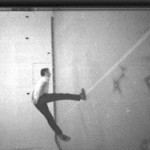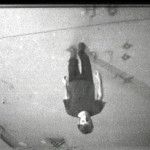By MARTINA TANGA
Bouncing two balls between the floor and ceiling with changing rhythm (1967-68) is a ten minute long film where Bruce Nauman bounces two balls in his studio. Though first in control, Nauman seems to spend the rest of his time chasing after the two balls around his studio. He repeats this sequence of actions, seemingly aimlessly, apparently in a state of boredom. Apart from Bouncing two balls between the floor and ceiling with changing rhythms (1967-68), Nauman made other similar staged performances, for example, Stamping in the Studio (1968), Slow Angle Walk (1968), Playing a Note on the Violin while I Walk around the Studio(1968), and Dance Exercise in the Perimeter of a Square (1968).
What is the implication of creating art that is purposefully boring? Isn’t art supposed to be interesting, captivating, exciting, exhilarating? To situate and understand Nauman’s activity within the notion of boredom, to pose questions such as what and why these actions might have any value in being considered in this way, it is important to contextualise the meaning of boredom.
Boredom is symptomatic of Modernity. [1] In our modern comfortable lives we are not driven by the constant struggle for survival, as everything seems to be available at our fingertips. Whatever we desire may be just a phone call away; whatever we may want to know can be easily found through the internet. We are bombarded with new products left and right, the newest gadget that will solve all our problems. We fall into this state of numbness and aimlessness where we are not able to ignite our interests. We are exhausted by this satiety and ultimately repudiate it, becoming apathetic.
It is apparent in examining Nauman’s studio films, that boredom can be approached from two different, almost opposite directions. On the one hand, the artist’s state of boredom leads him to create art almost as a means of killing time. On the other hand, the viewer’s induced bored response to the mundane and monotone nature of the art work. These two typologies are different and have fundamentally different implications though stemming from the same germ; boredom. They explore the meaning of boredom within our modern and post modern condition and reveal a new outlook that is in itself never boring.
Nauman employs strategies of duration and repetition to render his films purposefully boring to watch. Though each individual film is only ten minutes long, Nauman intended to project them on a loop and repeated them over and over again without a determined length, lasting hypothetically forever. This indeterminacy, continuity and repetition were supposed to reflect time as it is in this state of suspended aimlessness[2]: as ‘on going activities’ [3]. Time, here, is not something that has been conquered, it is imprisoning. In this way, boredom’s relation to death is paradoxical because profound boredom is like some sort of death, while death itself is a total break from boredom – liberation. Boredom has to do with infinitude and nothingness. It is death within life, a non-life [4].
This generates an exhausting viewing experience. Nauman raises important questions of attention and duration in the viewing subject. Attention is strained by the recurring and monotone rhythm. It seems as though it could go on and on and on indefinitely. Even though there is some irregularity in the thumping of the balls in Bouncing two balls between the floor and ceiling with changing rhythms, the beat is constant enough. The exhaustive attention of the viewer is captured both visually and phonically. Repeated rhythm causes, from another point of view, a hypnotic quality. This effect is possibly not boring but mesmerizing, a sensation of being in some way put to sleep or into a trance. Nauman describes the sound as ‘a strange kind of feeling’ [5]. He states that he was interested in, for example, Playing a Note on the Violin while I Walk around the Studio, playing two notes very close together so that you could hear the beats in the harmonics [6]. Nauman’s films can create either a hypnotic or an uncanny, disorienting viewing experience.
Within the prolonged duration and repetition there are certain characteristics that seem to escape the predetermined logic of rhythm and setting. These characteristics could arouse the attention of the viewer. Such as, in Bouncing two balls between the floor and ceiling with changing rhythms, the alternation of Nauman’s throwing the ball; sometimes he throws the ball violently downwards at the floor and sometimes upwards towards the ceiling. Or, the fact that Nauman avoids stepping on the square on the floor where he throws the balls into. The elements of change, the certain characteristics that escape the static system, could possibly render the viewing process interesting. However, when these characteristics too are repeated, then they become boring to watch.
The theme of attention – more specifically, the viewer’s attention of the art work – is epitomized by Nauman’s work of art; Please Pay Attention Please (1973). Janet Kraynak has noted that this work shows linguistic urgency of the proverbial pointing of the finger. The works seems to call out directly to the viewer. It is a statement of explicit address, assertions and demands [7]. However, Nauman is here implying more than just confronting the viewer, he is begging for the viewer’s attention. Nauman is putting into words what he expressed in his films. He is beseeching the viewer’s attention in a way that tests how long he can demand it before it becomes fatigued and exhausted.
While viewing these films, it is evident that all these short films involve, at a basic level, Nauman performing an activity repeatedly in his studio. Sometimes aided by a prop, Nauman performs an activity consistently and constantly using his own body as his only means. No distractions but himself.
Boredom presupposes subjectivity, more specifically self-awareness [8]. Subjectivity is a necessary but not sufficient condition for boredom. To be able to be bored the subject must be able to perceive himself as an individual searching for meaning and that this subject demands meaning of the world and himself [9]. By using his own body, Nauman discloses a certain subjectivity and awareness about himself, his studio and the space he inhabits.
Boredom, as an artistic condition for the creation of art, has a direct implication on the nature of the work. Behind these films, stemmed from the questioning what art should or should not be, Nauman, alone in his studio recounts that:
‘This raised the fundamental question of what an artist does when left alone in the studio. My conclusion was that I was an artist and I was in the studio, then whatever I was doing in the studio must be art […] At this point art became more of an activity and less of a product.’ [10]
Neal Benezra points out that the idea behind these films is to break free from traditional concepts of what art was and experiment to see what art could be. Among exploring the concepts of the body, space, phenomenology, and the traditions of sculpture in almost every regard [11], Nauman’s films put pressure on the very notion of art by creating art out of boredom. This goes against our conventional conception of how art is made and for what reasons. We understand that art is created with a purpose, with an aim or aspiration. We envisage a motive for the creation of art, not that it happens as a way to kill time. Nauman’s repeated actions are just that. His occupation is an activity of self amusement, an activity enacted to avoid boredom.[12]
Near the end of this exercise, Nauman gives up the activity of throwing the balls round the room out of physical fatigue and consequently anger. As he recounts in an interview with Willoughby Sharp:
‘Finally I lost track of both [the balls]. I picked one of the balls and just threw it against the wall. I was really mad […] because I was losing control of the game. There was a rhythm going and when I lost it that ended the film.’ [13]
What prompted Nauman to end the film was both physical exhaustion and mental tiredness. To avoid boredom Nauman has become engrossed in an activity which eventually fatigues him to the point of anger. This reaction is embedded in boredom’s terminology. The French ennui and the Italian noia, both of which, through the Provençal enojo, have roots in the Latin inodiare – ‘to hate’ or ‘detest’ – go back as far as the thirteenth century. [14]
Nauman explores boredom both through his own physical means and through the viewer’s response to his work. Nauman, in his films, directly explores notions of the phenomenology, artistic preoccupation with the expressive qualities of the body and the artist in his studio. Also, on a wider scope, Nauman uses film in a new artistic way of producing art. However, what is truly groundbreaking is the production of art by carrying out mundane and boring actions and consequently making the viewer aware of this intentional platitudinous viewing experience. This realisation should make us sit up with a jolt, make us reflect on this state of being and realise that this state is symptomatic of our modernity, and is consequently extremely insightful. Though Nauman’s studio films may be boring to watch, they are never be boring per se.
- Bruce Nauman, still from Slow Angle Walk, video, 1968
- Bruce Nauman, still from Stamping in the Studio, video, 1968
[1] Svendsen, A Philosophy of Boredom, p.11
[2] Butterfield, Bruce Nauman: The Centre of Yourself, p. 83
[3] Sharp, Interview with Bruce Nauman p. 124
[4] Svendsen, p. 40
[5] Sharp, p. 145
[6] Sharp, p. 146
[7] Kraynak, Please Pay Attention Please: Bruce Nauman’s Words, Writings and Interviews, p. 15
[8] Svendsen, p. 32
[9] Svendsen, p. 33
[10] Benezra, Bruce Nauman p. 23
[11] Benezra, p. 19
[12] Svendsen, p. 23
[13] Sharp, p. 146
[14] Svendsen, p. 24
Bruce Nauman - Wikipedia
Bruce Nauman - Art:21
All images are courtesy of The Tate Liverpool






